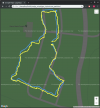Motor and Wheel Mounting Methods
-
- Last edited 3 years ago by Charlie Payne
-
We use three different methods when it comes to mounting wheels on our robots and we use abbreviations in the robot names to indicate which method we use in that particular robot. The three abbreviations we use are DM (direct mount), SB (single bearing), and DB (dual bearing). Direct mount is the cheapest and easiest but should only be used for light duty payloads or with heavy duty motors. The motor shaft takes all of the weight of the robot and any load applied to the robot. Single bearing is a much more robust design, where a ball bearing takes most of the load off of the motor shaft and puts it on the chassis/motor mount. The motor is still direct driving the wheel, however, so it will still take some of the load. The most robust system is the dual bearing system. In this, the wheel axle is mounted on two bearings and chain driven. This takes all of the load off of the motor and puts it on the chassis/motor mount. It also allows for easy adjustment of speed (or power) by changing gearing ratios of the sprockets. See below for an idea of load capacity for each size of motor and for each method. The motor mount tubes that we describe in this post use the SB method.
Contents
Tubing Motor Mounts
If you're looking for a simple yet sturdy way to mount a motor and an ATR shaft without buying a welded chassis, try our motor mount tubes. We machine them to mount our motor mount plates on one side and a flanged ball bearing on the other side. Slide a wheel shaft through the bearing onto the motor shaft and fix a couple of shaft collars and you’re in business. We make two versions, one for our IG32 and IG42 motors and one for our IG52 motors. See the lists at the bottom of the page to make sure get everything you need to mount a motor, shaft, and a wheel. There are lists for each motor size.
Tube Mounting Instructions
First, mount the motor to the motor plate. Next mount the motor plate to the motor tube using either the motor plate hardware kit (IG32 and IG42) or the hardware that comes with the motor tube (IG52). Next, mount your wheel to the shaft using the hardware in the wheel. Slide a shaft collar, a bearing, and then another shaft collar (with the long set screw) onto the shaft, and then slide the wheel shaft onto the motor shaft. Push the bearing into the hole on the motor tube and press the shaft collar against it and tighten the set screw. Finally tighten the long set screw through the hole in the wheel shaft onto the motor shaft, making sure the set screw is tightened onto the center of the flat spot on the motor shaft. Make sure to use locktite on all screws so they don’t back out.
You can make a simple 2WD robot by using two of these motor tube assemblies, a caster, and a base plate (like we’ve done with our 2WD Robot kit). For the base plate, you can use aluminum, plywood, plastic, or whatever else you’d like. We’ve used aluminum for ours.
To complete your RC robot, you’ll need batteries, a motor controller, and an RC Controller. You might also want a battery charger. And don’t forget to check out our How to Build a Robot support page for more help.
Sub-Heading Section
This is the first section of the support topic. If you need for provide emphasis on text, use BOLD TEXT. If you need to add a note, comment, or subtle emphasis, use ITALIC TEXT.
This is a link to the main SuperDroid Robots Shop Page
Sub-Heading Section 2
Shenzhen 12.8V LiFePO4 Battery 42Ah
http://www.superdroidrobots.com/index.php?route=product/category&path=97
http://www.superdroidrobots.com/index.php?route=product/category&path=3514661
| Electrical Specs: Voltage and Current | Control Inputs | |||||||
|---|---|---|---|---|---|---|---|---|
| Motor Controller | Channels | Min Voltage (VDC) | Max Voltage (VDC) | Continuous Current per Motor (A) | Peak Current per Motor (A) | Analog | RC | Serial |
| Sabertooth 2x5 | 2 | 6 | 18 | 5 | 10 | Y | Y |
Y |
| Sabertooth 2x12 | 2 | 12 | 24 | 12 | 25 | Y |
Y |
Y |
| Sabertooth 2x12 RC | 2 | 12 | 24 | 12 | 25 | Y |
Y |
Y |
| Sabertooth 2x25 | 2 | 12 | 24 | 25 | 50 | Y |
Y |
Y |
